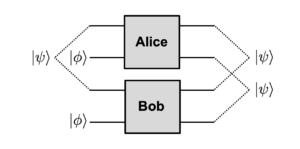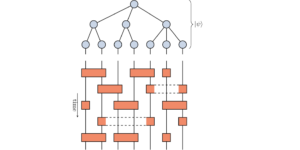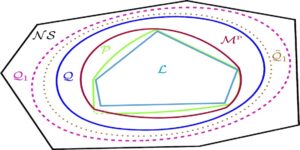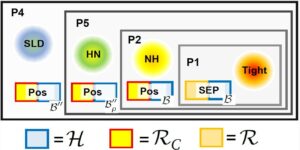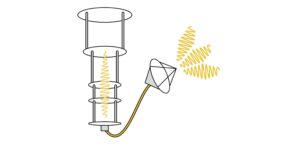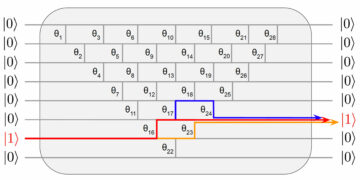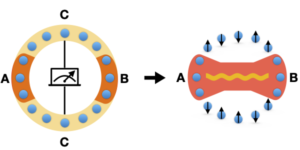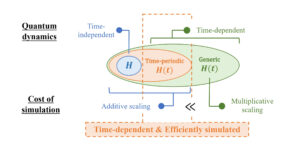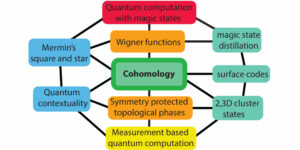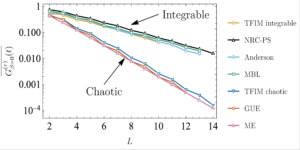1School of Physics & Astronomy, Monash University, Victoria 3800, Australia
2Hon Hai Quantum Computing Research Center, Taipei, Taiwan
3Física Teòrica: Informació i Fenòmens Quàntics, Departament de Física, Universitat Autònoma de Barcelona, 08193 Bellaterra (Barcelona), Spain
Find this paper interesting or want to discuss? Scite or leave a comment on SciRate.
Abstract
Equilibrium statistical mechanics provides powerful tools to understand physics at the macroscale. Yet, the question remains how this can be justified based on a microscopic quantum description. Here, we extend the ideas of pure state quantum statistical mechanics, which focus on single time statistics, to show the equilibration of isolated quantum processes. Namely, we show that most multitime observables for sufficiently large times cannot distinguish a nonequilibrium process from an equilibrium one, unless the system is probed for an extremely large number of times or the observable is particularly fine-grained. A corollary of our results is that the size of non-Markovianity and other multitime characteristics of a nonequilibrium process also equilibrate.
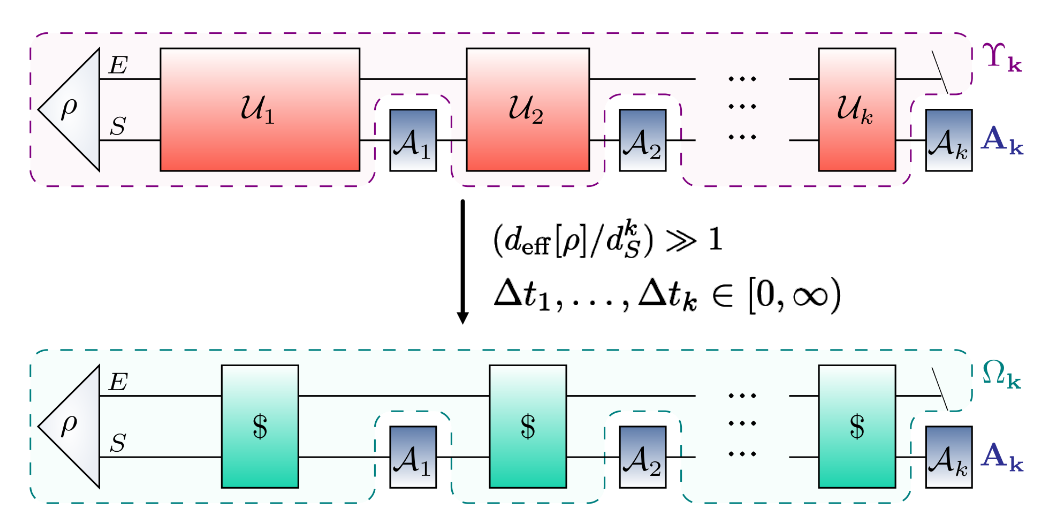
Featured image: An arbitrary, time-dependent multitime expectation value $langle textbf{A}_textbf{k} rangle_{Upsilon} (Delta t_1, dots,Delta t_k ) $ is shown (top), which can be computed from a quantum process tensor $Upsilon$, composed of unitary evolution superoperators $mathcal{U}_i$ and some initial state $rho$. For a system with where the initial state overlaps significantly with many energy eigenstates, if the system is not probed too many times $k$, we show that on average this multitime correlation function is indistinguishable from a time-independent equilibrium quantity (bottom), $langle textbf{A}_textbf{k} rangle_{Omega}$.
Popular summary
► BibTeX data
► References
[1] A. Rivas and S. F. van Huelga, Open Quantum Systems (Springer-Verlag, 2012).
https://doi.org/10.1007/978-3-642-23354-8
[2] I. Rotter and J. P. Bird, Rep. Prog. Phys. 78, 114001 (2015).
https://doi.org/10.1088/0034-4885/78/11/114001
[3] N. Pottier, Nonequilibrium Statistical Physics: Linear Irreversible Processes, Oxford Graduate Texts (Oxford University Press, 2010).
[4] R. Kubo, Rep. Prog. Phys. 29, 255 (1966).
https://doi.org/10.1088/0034-4885/29/1/306
[5] U. Weiss, Quantum Dissipative Systems, 4th ed. (World Scientific, 2012).
https://doi.org/10.1142/8334
[6] G. Stefanucci and R. van Leeuwen, Nonequilibrium Many-Body Theory of Quantum Systems: A Modern Introduction (Cambridge University Press, 2013).
https://doi.org/10.1017/CBO9781139023979
[7] M. Lax, Phys. Rev. 157, 213 (1967).
https://doi.org/10.1103/PhysRev.157.213
[8] F. A. Pollock, C. Rodríguez-Rosario, T. Frauenheim, M. Paternostro, and K. Modi, Phys. Rev. A 97, 012127 (2018a).
https://doi.org/10.1103/PhysRevA.97.012127
[9] F. A. Pollock, C. Rodríguez-Rosario, T. Frauenheim, M. Paternostro, and K. Modi, Phys. Rev. Lett. 120, 040405 (2018b).
https://doi.org/10.1103/PhysRevLett.120.040405
[10] L. Li, M. J. Hall, and H. M. Wiseman, Phys. Rep. 759, 1 (2018), concepts of quantum non-Markovianity: A hierarchy.
https://doi.org/10.1016/j.physrep.2018.07.001
[11] S. Milz, F. Sakuldee, F. A. Pollock, and K. Modi, Quantum 4, 255 (2020a).
https://doi.org/10.22331/q-2020-04-20-255
[12] S. Milz and K. Modi, PRX Quantum 2, 030201 (2021).
https://doi.org/10.1103/PRXQuantum.2.030201
[13] N. Dowling, P. Figueroa-Romero, F. Pollock, P. Strasberg, and K. Modi, ``Equilibration of non-markovian quantum processes in finite time intervals,'' (2021), arXiv:2112.01099 [quant-ph].
https://doi.org/10.48550/arXiv.2112.01099
arXiv:2112.01099
[14] N. Linden, S. Popescu, A. J. Short, and A. Winter, Phys. Rev. E 79, 061103 (2009).
https://doi.org/10.1103/PhysRevE.79.061103
[15] C. Neuenhahn and F. Marquardt, Phys. Rev. E 85, 060101(R) (2012).
https://doi.org/10.1103/PhysRevE.85.060101
[16] L. Campos Venuti and P. Zanardi, Phys. Rev. A 81, 022113 (2010).
https://doi.org/10.1103/PhysRevA.81.022113
[17] P. Bocchieri and A. Loinger, Phys. Rev. 107, 337 (1957).
https://doi.org/10.1103/PhysRev.107.337
[18] C. Gogolin and J. Eisert, Rep. Prog. Phys. 79, 056001 (2016).
https://doi.org/10.1088/0034-4885/79/5/056001
[19] L. C. Venuti, ``The recurrence time in quantum mechanics,'' (2015), arXiv:1509.04352 [quant-ph].
https://doi.org/10.48550/arXiv.1509.04352
arXiv:1509.04352
[20] P. Reimann, Phys. Rev. Lett. 101, 190403 (2008).
https://doi.org/10.1103/PhysRevLett.101.190403
[21] Á. M. Alhambra, J. Riddell, and L. P. García-Pintos, Phys. Rev. Lett. 124, 110605 (2020).
https://doi.org/10.1103/PhysRevLett.124.110605
[22] P. Figueroa-Romero, F. A. Pollock, and K. Modi, Commun. Phys. 4, 127 (2021).
https://doi.org/10.1038/s42005-021-00629-w
[23] J. Gemmer, M. Michel, and G. Mahler, Quantum Thermodynamics: Emergence of Thermodynamic Behavior Within Composite Quantum Systems, Lecture Notes in Physics (Springer Berlin Heidelberg, 2009).
https://doi.org/10.1007/b98082
[24] L. D'Alessio, Y. Kafri, A. Polkovnikov, and M. Rigol, Adv. Phys. 65, 239 (2016).
https://doi.org/10.1080/00018732.2016.1198134
[25] T. Mori, T. N. Ikeda, E. Kaminishi, and M. Ueda, J. Phys. B: At. Mol. Opt. 51, 112001 (2018).
https://doi.org/10.1088/1361-6455/aabcdf
[26] F. Costa and S. Shrapnel, New J. Phys. 18, 063032 (2016).
https://doi.org/10.1088/1367-2630/18/6/063032
[27] G. Chiribella, G. M. D'Ariano, and P. Perinotti, Phys. Rev. A 80, 022339 (2009).
https://doi.org/10.1103/PhysRevA.80.022339
[28] H. Tasaki, Phys. Rev. Lett. 80, 1373 (1998).
https://doi.org/10.1103/PhysRevLett.80.1373
[29] A. J. Short, New J. Phys. 13, 053009 (2011).
https://doi.org/10.1088/1367-2630/13/5/053009
[30] M. Ueda, Nat. Rev. Phys. 2, 669 (2020).
https://doi.org/10.1038/s42254-020-0237-x
[31] E. B. Davies and J. T. Lewis, Commun. Math. Phys. 17, 239 (1970).
https://doi.org/10.1007/BF01647093
[32] G. Chiribella, G. M. D`Ariano, and P. Perinotti, EPL (Europhysics Letters) 83, 30004 (2008).
https://doi.org/10.1209/0295-5075/83/30004
[33] L. Hardy, J. Phys. A-Math. Theor. 40, 3081 (2007).
https://doi.org/10.1088/1751-8113/40/12/s12
[34] L. Hardy, Philos. T. R. Soc. A 370, 3385 (2012).
https://doi.org/10.1098/rsta.2011.0326
[35] L. Hardy, ``Operational general relativity: Possibilistic, probabilistic, and quantum,'' (2016), arXiv:1608.06940 [gr-qc].
https://doi.org/10.48550/arXiv.1608.06940
arXiv:1608.06940
[36] J. Cotler, C.-M. Jian, X.-L. Qi, and F. Wilczek, J. High Energy Phys. 2018, 93 (2018).
https://doi.org/10.1007/JHEP09(2018)093
[37] D. Kretschmann and R. F. Werner, Phys. Rev. A 72, 062323 (2005).
https://doi.org/10.1103/PhysRevA.72.062323
[38] F. Caruso, V. Giovannetti, C. Lupo, and S. Mancini, Rev. Mod. Phys. 86, 1203 (2014).
https://doi.org/10.1103/RevModPhys.86.1203
[39] C. Portmann, C. Matt, U. Maurer, R. Renner, and B. Tackmann, IEEE Transactions on Information Theory 63, 3277 (2017).
https://doi.org/10.1109/TIT.2017.2676805
[40] S. Shrapnel, F. Costa, and G. Milburn, New J. Phys. 20, 053010 (2018).
https://doi.org/10.1088/1367-2630/aabe12
[41] O. Oreshkov, F. Costa, and Č. Brukner, Nat. Commun. 3, 1092 (2012).
https://doi.org/10.1038/ncomms2076
[42] P. Strasberg, Phys. Rev. E 100, 022127 (2019a).
https://doi.org/10.1103/PhysRevE.100.022127
[43] C. Giarmatzi and F. Costa, Quantum 5, 440 (2021).
https://doi.org/10.22331/q-2021-04-26-440
[44] P. Strasberg and A. Winter, Phys. Rev. E 100, 022135 (2019).
https://doi.org/10.1103/PhysRevE.100.022135
[45] P. Strasberg, Phys. Rev. Lett. 123, 180604 (2019b).
https://doi.org/10.1103/PhysRevLett.123.180604
[46] P. Strasberg and M. G. Díaz, Phys. Rev. A 100, 022120 (2019).
https://doi.org/10.1103/PhysRevA.100.022120
[47] S. Milz, D. Egloff, P. Taranto, T. Theurer, M. B. Plenio, A. Smirne, and S. F. Huelga, Phys. Rev. X 10, 041049 (2020b).
https://doi.org/10.1103/PhysRevX.10.041049
[48] V. Chernyak, F. c. v. Šanda, and S. Mukamel, Phys. Rev. E 73, 036119 (2006).
https://doi.org/10.1103/PhysRevE.73.036119
[49] G. S. Engel, T. R. Calhoun, E. L. Read, T.-K. Ahn, T. Mančal, Y.-C. Cheng, R. E. Blankenship, and G. R. Fleming, Nature 446, 782 (2007).
https://doi.org/10.1038/nature05678
[50] F. Krumm, J. Sperling, and W. Vogel, Phys. Rev. A 93, 063843 (2016).
https://doi.org/10.1103/PhysRevA.93.063843
[51] E. Moreva, M. Gramegna, G. Brida, L. Maccone, and M. Genovese, Phys. Rev. D 96, 102005 (2017).
https://doi.org/10.1103/PhysRevD.96.102005
[52] H. G. Duan, V. I. Prokhorenko, R. J. Cogdell, K. Ashraf, A. L. Stevens, M. Thorwart, and R. J. D. Miller, Proc Natl Acad Sci U S A 114, 8493 (2017).
https://doi.org/10.1073/pnas.1702261114
[53] M. Ringbauer, F. Costa, M. E. Goggin, A. G. White, and A. Fedrizzi, npj Quantum Information 4, 37 (2018).
https://doi.org/10.1038/s41534-018-0086-y
[54] G. A. L. White, C. D. Hill, F. A. Pollock, L. C. L. Hollenberg, and K. Modi, Nature Communications 11, 6301 (2020).
https://doi.org/10.1038/s41467-020-20113-3
[55] G. A. L. White, F. A. Pollock, L. C. L. Hollenberg, C. D. Hill, and K. Modi, ``From many-body to many-time physics,'' (2022), arXiv:2107.13934 [quant-ph].
https://doi.org/10.48550/arXiv.2107.13934
arXiv:2107.13934
[56] L. Knipschild and J. Gemmer, Phys. Rev. E 101, 062205 (2020).
https://doi.org/10.1103/PhysRevE.101.062205
[57] P. Taranto, F. A. Pollock, and K. Modi, npj Quantum Information 7, 149 (2021).
https://doi.org/10.1038/s41534-021-00481-4
[58] S. Milz, M. S. Kim, F. A. Pollock, and K. Modi, Phys. Rev. Lett. 123, 040401 (2019).
https://doi.org/10.1103/PhysRevLett.123.040401
[59] D. Burgarth, P. Facchi, M. Ligabò, and D. Lonigro, Phys. Rev. A 103, 012203 (2021a).
https://doi.org/10.1103/PhysRevA.103.012203
[60] D. Burgarth, P. Facchi, D. Lonigro, and K. Modi, Phys. Rev. A 104, L050404 (2021b).
https://doi.org/10.1103/PhysRevA.104.L050404
[61] F. G. S. L. Brandão, E. Crosson, M. B. Şahinoğlu, and J. Bowen, Phys. Rev. Lett. 123, 110502 (2019).
https://doi.org/10.1103/PhysRevLett.123.110502
[62] J. M. Deutsch, Phys. Rev. A 43, 2046 (1991).
https://doi.org/10.1103/PhysRevA.43.2046
[63] M. Srednicki, Phys. Rev. E 50, 888 (1994).
https://doi.org/10.1103/PhysRevE.50.888
[64] M. Srednicki, J. Phys. A-Math. Gen. 32, 1163 (1999).
https://doi.org/10.1088/0305-4470/32/7/007
[65] M. Rigol, V. Dunjko, V. Yurovsky, and M. Olshanii, Phys. Rev. Lett. 98, 050405 (2007).
https://doi.org/10.1103/PhysRevLett.98.050405
[66] M. Rigol, V. Dunjko, and M. Olshanii, Nature 452, 854 EP (2008).
https://doi.org/10.1038/nature06838
[67] C. J. Turner, A. A. Michailidis, D. A. Abanin, M. Serbyn, and Z. Papić, Nat. Phys. 14, 745 (2018).
https://doi.org/10.1038/s41567-018-0137-5
[68] J. M. Deutsch, Rep. Prog. Phys. 81, 082001 (2018).
https://doi.org/10.1088/1361-6633/aac9f1
[69] J. Richter, J. Gemmer, and R. Steinigeweg, Phys. Rev. E 99, 050104(R) (2019).
https://doi.org/10.1103/PhysRevE.99.050104
[70] S. Milz, C. Spee, Z.-P. Xu, F. A. Pollock, K. Modi, and O. Gühne, SciPost Phys. 10, 141 (2021).
https://doi.org/10.21468/SciPostPhys.10.6.141
[71] R. Dümcke, J. Math. Phys. 24, 311 (1983).
https://doi.org/10.1063/1.525681
[72] P. Figueroa-Romero, K. Modi, and F. A. Pollock, Quantum 3, 136 (2019).
https://doi.org/10.22331/q-2019-04-30-136
[73] Alexei Kitaev, ``2015 breakthrough prize fundamental physics symposium,'' url: https://breakthroughprize.org/Laureates/1/L3 (2014).
https://breakthroughprize.org/Laureates/1/L3
[74] M. Zonnios, J. Levinsen, M. M. Parish, F. A. Pollock, and K. Modi, Phys. Rev. Lett. 128, 150601 (2022).
https://doi.org/10.1103/PhysRevLett.128.150601
[75] N. Dowling and K. Modi, ``Quantum chaos = volume-law spatiotemporal entanglement,'' (2022), arXiv:2210.14926 [quant-ph].
https://doi.org/10.48550/ARXIV.2210.14926
arXiv:2210.14926
[76] G. Styliaris, N. Anand, and P. Zanardi, Phys. Rev. Lett. 126, 030601 (2021).
https://doi.org/10.1103/PhysRevLett.126.030601
[77] A. J. Short and T. C. Farrelly, New J. Phys. 14, 013063 (2012).
https://doi.org/10.1088/1367-2630/14/1/013063
[78] A. Riera, C. Gogolin, and J. Eisert, Phys. Rev. Lett. 108, 080402 (2012).
https://doi.org/10.1103/PhysRevLett.108.080402
[79] A. S. L. Malabarba, L. P. García-Pintos, N. Linden, T. C. Farrelly, and A. J. Short, Phys. Rev. E 90, 012121 (2014).
https://doi.org/10.1103/PhysRevE.90.012121
[80] H. Wilming, T. R. de Oliveira, A. J. Short, and J. Eisert, ``Equilibration times in closed quantum many-body systems,'' in Thermodynamics in the Quantum Regime: Fundamental Aspects and New Directions, edited by F. Binder, L. A. Correa, C. Gogolin, J. Anders, and G. Adesso (Springer International Publishing, Cham, 2018) pp. 435–455.
https://doi.org/10.1007/978-3-319-99046-0_18
[81] S. Milz, F. A. Pollock, and K. Modi, Open Syst. Inf. Dyn. 24, 1740016 (2017).
https://doi.org/10.1142/S1230161217400169
[82] J. Watrous, The Theory of Quantum Information (Cambridge University Press, 2018).
https://doi.org/10.1017/9781316848142
[83] M. M. Wilde, ``From Classical to Quantum Shannon Theory,'' (2011), arXiv:1106.1445 [quant-ph].
https://doi.org/10.1017/9781316809976.001
arXiv:1106.1445
[84] J. Watrous, Quantum Inf. Comput. 5 (2004), 10.26421/QIC5.1-6.
https://doi.org/10.26421/QIC5.1-6
[85] P. Taranto, S. Milz, F. A. Pollock, and K. Modi, Phys. Rev. A 99, 042108 (2019).
https://doi.org/10.1103/PhysRevA.99.042108
[86] W. R. Inc., ``Mathematica, Version 12.3.1,'' Champaign, IL, 2021.
[87] J. Miszczak, Z. Puchała, and P. Gawron, ``Qi package for anaylsis of quantum systems,'' (2011-).
https://github.com/iitis/qi
Cited by
[1] Philipp Strasberg, "Classicality with(out) decoherence: Concepts, relation to Markovianity, and a random matrix theory approach", arXiv:2301.02563, (2023).
[2] Philipp Strasberg, Teresa E. Reinhard, and Joseph Schindler, "Everything Everywhere All At Once: A First Principles Numerical Demonstration of Emergent Decoherent Histories", arXiv:2304.10258, (2023).
[3] Philipp Strasberg, Andreas Winter, Jochen Gemmer, and Jiaozi Wang, "Classicality, Markovianity and local detailed balance from pure state dynamics", arXiv:2209.07977, (2022).
[4] Neil Dowling and Kavan Modi, "Quantum Chaos = Volume-Law Spatiotemporal Entanglement", arXiv:2210.14926, (2022).
[5] I. A. Aloisio, G. A. L. White, C. D. Hill, and K. Modi, "Sampling Complexity of Open Quantum Systems", PRX Quantum 4 2, 020310 (2023).
[6] Neil Dowling, Pedro Figueroa-Romero, Felix A. Pollock, Philipp Strasberg, and Kavan Modi, "Equilibration of Multitime Quantum Processes in Finite Time Intervals", arXiv:2112.01099, (2021).
[7] Pengfei Wang, Hyukjoon Kwon, Chun-Yang Luan, Wentao Chen, Mu Qiao, Zinan Zhou, Kaizhao Wang, M. S. Kim, and Kihwan Kim, "Demonstration of multi-time quantum statistics without measurement back-action", arXiv:2207.06106, (2022).
The above citations are from SAO/NASA ADS (last updated successfully 2023-06-04 12:55:03). The list may be incomplete as not all publishers provide suitable and complete citation data.
On Crossref's cited-by service no data on citing works was found (last attempt 2023-06-04 12:55:02).
This Paper is published in Quantum under the Creative Commons Attribution 4.0 International (CC BY 4.0) license. Copyright remains with the original copyright holders such as the authors or their institutions.
- SEO Powered Content & PR Distribution. Get Amplified Today.
- PlatoAiStream. Web3 Data Intelligence. Knowledge Amplified. Access Here.
- Minting the Future w Adryenn Ashley. Access Here.
- Buy and Sell Shares in PRE-IPO Companies with PREIPO®. Access Here.
- Source: https://quantum-journal.org/papers/q-2023-06-01-1027/
- :is
- :not
- :where
- ][p
- 1
- 10
- 100
- 107
- 11
- 12
- 13
- 14
- 15%
- 16
- 17
- 1994
- 1998
- 1999
- 20
- 2005
- 2006
- 2008
- 2011
- 2012
- 2013
- 2014
- 2015
- 2016
- 2017
- 2018
- 2019
- 2020
- 2021
- 2022
- 2023
- 22
- 23
- 24
- 26
- 27
- 28
- 30
- 31
- 39
- 40
- 49
- 4th
- 50
- 60
- 66
- 67
- 7
- 70
- 72
- 77
- 8
- 80
- 84
- 87
- 9
- 98
- a
- above
- ABSTRACT
- access
- Additional
- affiliations
- All
- alone
- also
- amount
- an
- and
- any
- approach
- approximately
- ARE
- AS
- Ashraf
- aspects
- astronomy
- At
- author
- authors
- average
- Balance
- barcelona
- based
- BE
- belief
- berlin
- bird
- both
- Bottom
- Break
- breakthrough
- by
- cambridge
- CAN
- cannot
- Center
- Chaos
- characteristics
- chen
- Cheng
- closed
- comment
- Commons
- Communications
- complete
- complexity
- composed
- computing
- computing research
- concepts
- constantly
- copyright
- Correlation
- data
- Delta
- Den
- description
- Despite
- detailed
- determining
- directions
- discuss
- distinguish
- dynamics
- e
- ed
- emergence
- energy
- enough
- Equilibrium
- Ether (ETH)
- everything
- evolution
- evolving
- expectation
- extend
- extremely
- Features
- fine
- First
- Focus
- For
- found
- from
- function
- fundamental
- Gen
- General
- graduate
- Hall
- harvard
- Held
- here
- hierarchy
- High
- highly
- holders
- How
- HTTPS
- i
- ideas
- IEEE
- if
- image
- in
- Inc.
- independent
- information
- initial
- institutions
- interesting
- International
- Introduction
- isolated
- IT
- JavaScript
- journal
- Key
- Kim
- Kwon
- large
- Last
- Leave
- Lecture
- Lewis
- li
- License
- List
- local
- Look
- many
- math
- Matrix
- max-width
- May..
- means
- measurement
- mechanics
- Memory
- Miller
- Modern
- MOL
- Month
- most
- namely
- Nature
- New
- no
- Notes
- number
- observe
- of
- on
- once
- ONE
- open
- or
- original
- Other
- our
- out
- Oxford
- oxford university
- package
- Paper
- particularly
- Physics
- piece
- plato
- Plato Data Intelligence
- PlatoData
- powerful
- press
- principles
- prize
- PROC
- process
- processes
- properties
- provide
- provides
- published
- publisher
- publishers
- Publishing
- puzzle
- Qi
- quantity
- Quantum
- quantum computing
- quantum information
- Quantum Mechanics
- quantum systems
- question
- random
- Read
- recurrence
- references
- regime
- relation
- relativity
- relaxation
- relevant
- remains
- research
- Results
- Richter
- s
- SCI
- Short
- should
- show
- shown
- significantly
- single
- Size
- some
- Space
- Space and Time
- State
- statistical
- statistics
- Successfully
- such
- suitable
- Symposium
- system
- Systems
- that
- The
- their
- theory
- this
- time
- times
- Title
- to
- too
- tools
- top
- Transactions
- under
- understand
- university
- updated
- URL
- usually
- value
- Values
- version
- Victoria
- volume
- W
- want
- was
- we
- weiss
- when
- which
- white
- widely
- Winter
- with
- within
- without
- Work
- works
- world
- X
- year
- yet
- zephyrnet


